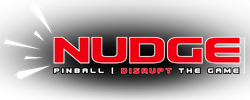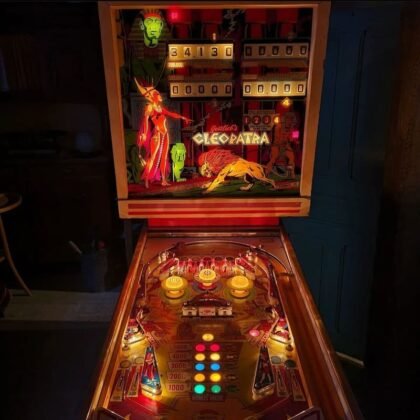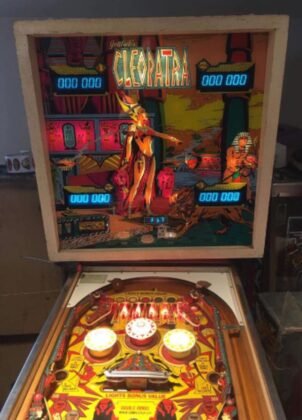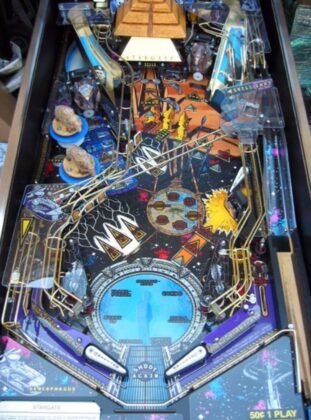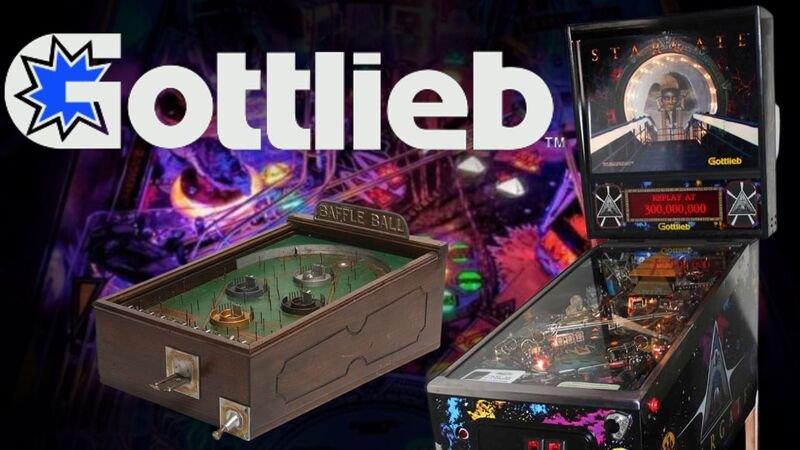
Gottlieb is known for its pinball machines, whose design is sometimes anachronistic in the age of DMDs, others that it had its golden age in the era of mechanical pinball machines, still others that it’s one of the brands that has produced the greatest number of good pinball machines… And we’ll try to explain why this brand is so much debated today, and is sometimes considered by some pinheads to be less interesting than its competitors…
Sommaire
The Gottlieb story
The beginnings of David Gottlieb
It all began in 1931, during the Great Depression in the United States, when David Gottlieb, founder of an automatic gaming company in 1927, decided to adapt the game of bagatelle. He offered a new, inexpensive form of entertainment in cafés and other public places. The “Baffle Ball” was a total success. Released just a few months after their first bagatelle, it sold over 50,000 copies.
This success led the company to produce a number of similar games in the years that followed, all based on the same principle: a board with nails, a ball that can be thrown at the intensity of your choice, and holes to score points. It was during these same years that the word “pinball” was coined. In 1932, Bally entered the competition with a machine that resembled a game of trifle. The “Ballyhoo” also sold almost 50,000 units. This competition gave rise to a heightened desire for innovation. Both brands invented the mechanisms we know today…
 Baffle Ball – Gottlieb
Baffle Ball – Gottlieb
The electromechanical era: a golden age for Gottlieb
In the mid-1930s, manufacturers were looking for ways to make their pinball machines more attractive. Indeed, it was often said that the games were always played in the same way and lacked action. In response, a competitor of Gottlieb’s began to use coils, essential for moving the ball from one hole to another and making bell-like sounds. He also invented the tilt, noting that players tended to lift the bottom of the machine to bring the ball up. So-called electromechanical pinball machines were born.
A few years of various innovations followed, until 1947, when Gottlieb marked a turning point in the history of pinball with a game-changing innovation: the flipper. Indeed, this “racket” that we use to send the ball back and make our shots was invented by Gottlieb in 1947. It was first seen on the Humpty Dumpty pinball machine, a revolutionary machine that changed the way we play.
For the record, the flippers on this machine were mounted in the opposite direction to the one we know today, with the left-hand flipper tilting clockwise and the right-hand flipper tilting counter-clockwise. It wasn’t long before all manufacturers began installing flippers to control the ball. The current flipper arrangement became the norm.
Gottlieb continued his series of innovative ideas, bringing out other revolutionary machines such as the Super Jumbo in 1954, which was the first to be able to play a 4-player game. The Airport, in 1969, introduced the vari-target, a target that scores more or less according to the force with which it is pushed. Other notable innovations included drop targets, roto-targets and much more… In fact, all these innovations made Gottlieb the undisputed leader in electromechanical pinball.
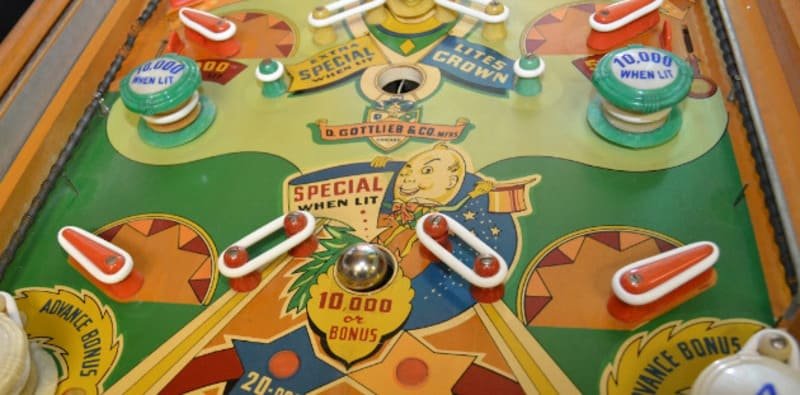
The transition to electronics
Around 1975, some pinball manufacturers, notably Bally, began producing electronic pinball machines, where all relays, motors, cams and other electromechanical controls were replaced by printed circuit boards. They incorporate firmware (the code) and digital screens to display the score. Success was immediate, and sales of electronic pinball machines exploded, to the detriment of electromechanical ones.
In fact, the general public was captivated by the arrival of electronic games, which were something of a novelty at the time. The arrival of these new machines would spur Gottlieb into action. Yet they had been enjoying and leading the way in electromechanical pinball, so why move on to a new technology? Well, quite simply because only two years later, in 1977, the majority of manufacturers were offering only electronic pinball machines!
In December of that year, Gottlieb released his first electronic pinball machine: Cleopatra. However, the Cleopatra game was also released in an electromechanical version, as were the following 7 games, proof of the brand’s love of this technology. Their first generation of electronic boards, the System1, had capacities more or less equivalent to those of an electromechanical pinball machine, although the following 8 tables, not electromechanical, were a little more advanced. However, the following technical choices are worth noting:
- Fluorescent displays, more reliable and legible than those of the competition.
- Some pinball machine components are still controlled electromechanically (bumpers, slingshots, etc.).
- For pinball machines produced in both electronic and electromechanical versions: the maximum score displayed is higher, the high-score is memorized and the multipliers are higher.
We can see from this first generation of cards, which were in use from 1977 to 1980, that Gottlieb had probably anticipated the switch to electronics. But they certainly didn’t plan to stop using electromechanical systems until the 1980s.
The 80s: Gottlieb’s tour de force
In 1980, Gottlieb unveiled the card that would replace System1: System 80. It was first used in the Spider-Man pinball game, released in May, and was considerably more advanced than its predecessor: light shows, attract mode, in-game progress memory, tenfold control capacity… It enables the creation of games that would make the competition swoon, such as the Black Hole game, a legendary pinball machine that was avant-garde in its day, with a lower board, two-level multiball, and so on! It also allows a new type of game to be played in limited time, with the James Bond 007 pinball machine, although this gameplay has received a mixed reception.
The first variant was released in 1982. The System 80a features more complete game rules and displays up to 9,999,990 points. The second variant, the System 80b, came out in 1985. It revolutionized the pinball market by introducing alphanumeric display, allowing numbers and letters, initials to be entered when beating a high score and much more… The new memory capacities of this variant also allow the rules to be more complete and offer better lighting effects with flashers. Gottlieb pinball machines of this era have one difference from the competition: they are almost all based on unlicensed themes. Some pinball machines were nevertheless inspired by films (e.g. Gold Wings for Top Gun) but did not have the rights.
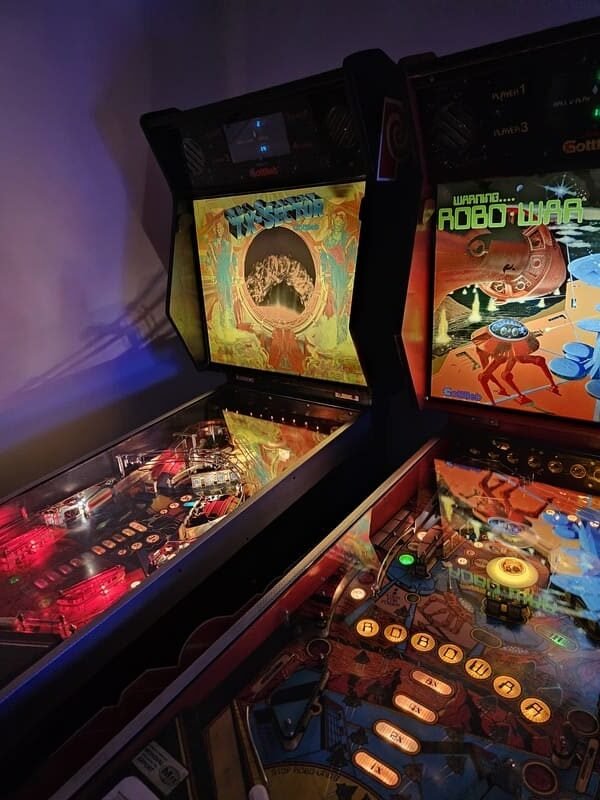

The transition to the 90s
At the end of 1989, Gottlieb introduced its new generation of electronic boards: the System 3. This board offered ten times the functionality of its predecessor and its competitors, and proved to be extremely reliable. The first game to be equipped with it was Light Camera Action, an excellent game that failed to achieve the success it deserved (with around 2000 units produced).
In 1990, Gottlieb decided to launch a new game format they called “Street Level Games”. With no ramps, slightly smaller and less expensive, they featured the very latest electronics and rather advanced gameplay, including Gottlieb’s first Wizard Mode on the Deadly Weapon in 1991. However, the success of this game series declined machine by machine, from over 2000 units for the Silver Slugger game, to less than 900 for the latest: Hoops.
This was probably due to the fact that the board appeared less visually busy than the others. Gottlieb then went back to making games in the traditional format, with ramps and a large-format board, which met with great success and became emblematic of the company.
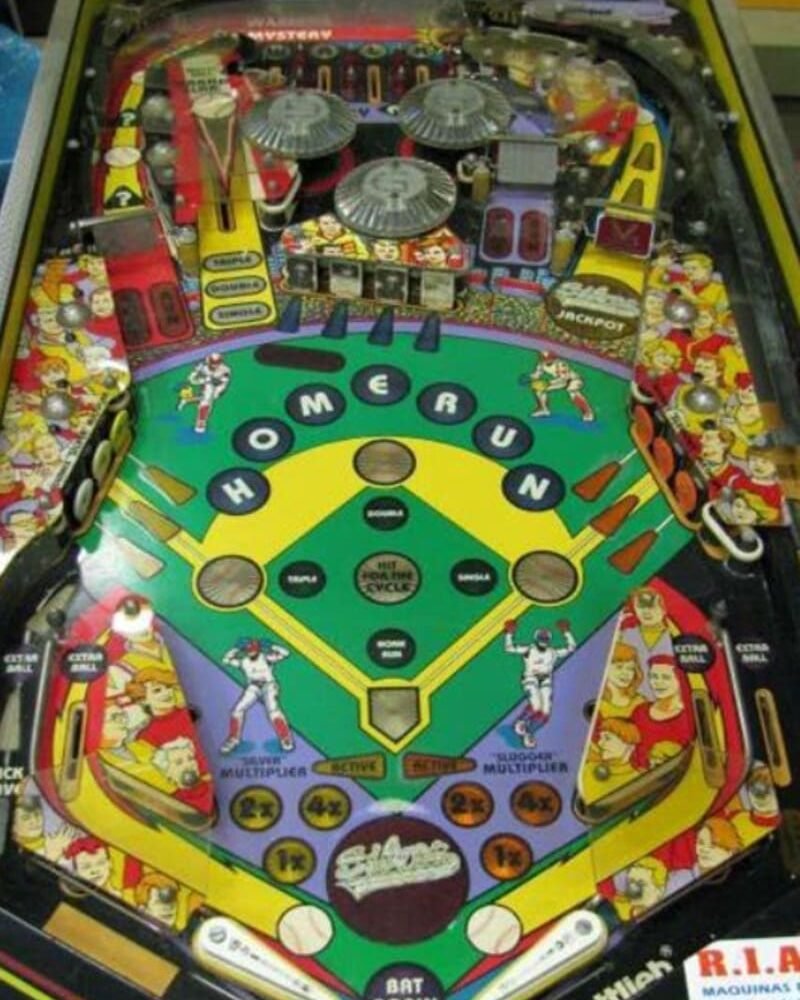
The Dot Matrix era: Gottlieb anachronistic?
In April 1992, Gottlieb unveiled its very first Dot Matrix Display pinball machine: Super Mario Bros. In doing so, Gottlieb made up for lost time with its competitors, who had switched to DMDs the previous year. It’s worth noting that, unlike the other players, Gottlieb is reusing its System 3 board, due to its already highly advanced technical capabilities at the time of its release.
So why do people say that Gottlieb’s DMD generation lacks originality or is not deep enough in its rules? Well, probably because gameplay on the Super Mario Bros pinball machine isn’t much more advanced than the vast majority of alphanumerics released in previous years, unlike the opponents’ games. In fact, there are only a few missions on this pinball machine and on most of Gottlieb’s subsequent DMD machines.
Yet Gottlieb’s pinball machines are not anachronistic per se, they simply offer different rules than those proposed by other brands, notably Williams and Bally. They are aimed at an audience that prefers pinball machines with simpler, more understandable scoring than that of a pinball machine like Twilight Zone, for example. The pinball machine that illustrates this perfectly is World Challenge Soccer: released for the 1994 Football World Cup, it is virtually identical to Car Hop, an alphanumeric pinball machine from the Street Level series marketed a few years earlier. Its gameplay is fun, but the game lacks the depth and missions of competing brands in the same year.
However, let’s not generalize: some of Gottlieb’s DMD games offer excellent rules. The Stargate pinball machine, for example, is widely recognized by pinheads as a pinball machine with advanced gameplay and an interesting layout. We could also mention Street Fighter 2, with its very difficult finale, and Gladiators, with its excellent flow.
In 1996, Gottlieb stopped making pinball machines. Investors felt that the company’s pinball arm was no longer profitable enough. The last machine produced by Gottlieb was the Barb-Wire, based on the movie of the same name starring Pamela Anderson. The Brooks and Dunn pinball machine was in preparation when the company closed, but only a prototype existed.
Gottlieb: innovation to the end
To conclude this article, here’s a brand that got off to a triumphant start, inventing the mechanism at the heart of every pinball machine and rapidly becoming the leader in the electromechanical pinball era. But it didn’t adapt quickly enough to electronics. It initially offered games whose design was too close to electromechanical ones.
In the 1980s, the company returned to the forefront with a revolutionary electronic system, offering innovative machines that rival the most advanced gameplays. The absence of themed machines in the second half of this decade is noteworthy. In the 90s, the brand changed its strategy, offering pinball machines with a different approach to the rest of the market, first with the Street Level series of games, on one level and without ramps, then with some of their dots with fairly simple rules, similar to those of alphanumeric pinball machines. And it’s probably for this reason that Gottlieb’s pinball machines are wrongly described as “inferior” to their competitors.
While this may seem true for a advanced gamer, fond of complex missions and wizard modes, we mustn’t forget that our clientele is and always will be made up of neophytes and occasional gamers, to whom Gottlieb’s machines seem more familiar!
Long live pinball, and long live Gottlieb, who has contributed the most beautiful stone to the edifice.
Author : Aaron
